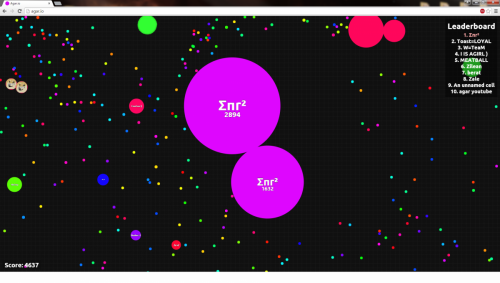-
Posts
719 -
Joined
-
Last visited
-
Days Won
2
Content Type
Profiles
Forums
Events
Everything posted by Daedalus
-
As is being said, you cannot imply a formula or equation for a set of numbers without some theory regarding how those numbers relate to each other. For instance, I have developed an exponential interpolation formula that will produce an exponential equation that can yield the set of numbers you posted. The following is from my Fourth Challenge and is an exponential interpolation for the points, (1,1), (2,2), (3,3), (4,4), and (5,5):
-
Every one of my songs are composed raw straight from my mind. Now, you can't really write something that's completely original, but it's not like I'm sitting down listening to other people's music and taking stuff from different songs. I'm sure there are components of my songs that can be found in other songs, but all of my songs come straight from the heart! With that being said, I'm sure you'll notice certain patterns that I like to use. They are a part of my style
-
There's a very special person in my life and I've been missing her like crazy. I miss her so much that I actually have the blues. What better way to express my feelings than in song? Enjoy!!!
-
Well, I was happier when I wrote it.
-
I have finished yet another composition. I wrote the melody to this song in high school. It has taken me 17 years to complete it. I'm just happy that my skills have grown to allow me to write what I hear in my heart. Enjoy!!! *Edit: I made a few changes to the spiccato violin parts, which are just awesome!
-
I use Pro-Tools to write the music. All of the sounds are the default XPand2 synth, which is ok but nothing like Garritan or Vienna Instruments. As for your track, pretty funky I like it. Besides composing classical music and playing it on the piano, I play neo-classical metal on guitar. Glad you liked the song.
-
I have several songs that I work on during the night. If I get stuck on one, then I move on to another. This song is different than most of my other songs. The tempo is slow and the melody is very peaceful. The fade at the end seems too fast, but the software I use makes it difficult to get those things just right. I'll keep messing with it and see if I can perfect it, but the songs is still very beautiful. Perhaps one day, I will be able to get an actual orchestra to records these songs and you will be able to hear them the way they were meant to be heard! Enjoy!!!
-
This is a song I wrote in high school. However, I didn't have the expertise that I have today. So, I applied my new skills to this remnant of the past! ; ) Enjoy!!!
-
1
-
Thanks Zapatos! I'm glad you enjoy the music!!! As a bonus, here is the HD rendering of the song complete with sheet music. The sheet music is in sync with the song. So, you can follow along if you like. Enjoy!!!
-
Thanks Moontanman! I made a few small changes and spiced up that ending. Here's the new link Enjoy!!!
-
Thanks Arc! I'm glad you enjoyed it
-
I finally finished my latest composition! It's a really beautiful piece of music!!! Enjoy!!!
-
-
I'm looking forward to my vacation coming up in August from the 19th to the 24th. I'm flying to NC to enjoy my week with a friend.

-
-
Well, it certainly has been quite a while since I've written a new song or made a post in the forum. I wrote this one for a friend as a birthday present. This song is titled, "Inspired", because of all the inspiration I obtained from listening to Mozart, and by talking to my friend, Doreen. This song is for her. Enjoy!!!
-
Work has been extremely busy, but I am almost done writing the Mathematica file explaining the mathematics for this latest challenge. So, you all still have some time to try and figure this one out.
-
I figured this one out by complete accident. Think about factorials and prime numbers.
-
Surely, someone is working on finding the equation that produces a 1 for prime numbers and a 0 for all other natural numbers. Even though it's a little challenging, the answer is actually pretty cool.
-
Well, it's been long enough and Md65536 did solve the original problem. So, I will give my usual breakdown for the general solution for this challenge. Considering how easy these challenges were, I will propose one more challenge that is similar in nature, but a little more complicated. Using some form of the equation [math]\frac{1-(-1)^{x}}{2}[/math] find the function that produces a 1 for prime numbers and a 0 everywhere else. I only used elementary operations (^,*,/,+,-) along with a factorial.
-
And, that is precisely why I wanted to explore my equation and methods myself before releasing my work. It's not that I'm worried that someone will steal my ideas for themselves, but that no one has really approached the problem from this angle. Because if they did, there would be references to the proofs my method has already produced. As is the case for proving that no odd number will iterate to an odd number that has a factor of three, or the Collatz coefficient as I define it. So, once again, I'm going to give you the method that I used to reverse the algorithm: Let's define the 3 in the rule for odd numbers in the Collatz conjecture as the Collatz coefficient, [math]C[/math] where [math]\left \{C \in \mathbb{N}, C\,\text{is odd}\right \}[/math], and let's define the 1 as the Collatz constant, [math]S[/math] where [math]\left \{S \in \mathbb{N}, S\,\text{is odd}\right \}[/math]. From the odd rule we know: [math]\text{even}=C(\text{odd}_1)+S=\text{odd}\times\text{odd}+\text{odd}[/math] [1] such that the inverse is: [math]\text{odd}_1=\frac{\text{even}-S}{C}[/math] [2] Given that all even numbers are odd numbers that contain factors of 2, we can redefine the equation for even numbers as: [math]\text{even} = (\text{odd}_2) 2^m[/math] [3] Now that we have an equation for all even numbers [3] and an equation for the odd rule [1], we set them equal to each other: [math](\text{odd}_2) 2^m = C(\text{odd}_1)+S[/math] and solve for [math]\text{odd}_1[/math] and values of [math]m[/math] that produce integer / natural number results: [math]\text{odd}_1 = \frac{(\text{odd}_2) 2^m-S}{C}[/math] [4] Because we are interested in odd numbers that reduce to one, we simply set [math]\text{odd}_2=1[/math]: [math]\text{odd}_1 = \frac{2^m-1}{3}[/math] and check for integer / natural number results: [math]{\frac{1}{3}, 1, \frac{7}{3}, 5, \frac{31}{3}, 21, \frac{127}{3}, 85, \frac{511}{3}, 341, ...}[/math] We can see that every other number is an integer / natural number so the equation that predicts all odd number that reduce to one in one iteration of the odd rule in the Collatz conjecture is: [math]\text{odd}_1 = \frac{2^{2m}-1}{3}[/math] [5] We can use induction to prove equation [5] is true, but I'll leave that as an exercise for the reader. From here, we want to know all of the odd numbers that reduce to one of the odd numbers predicted by equation [5]. That will give us every odd number that reduces to one in two iterations of the rule for odd numbers. By using equation [5] as the source for [math]\text{odd}_2[/math] in equation [4] , we can reverse the algorithm once again: [math]\text{odd}_1 = \frac{(\text{odd}_2) 2^m-S}{C} = \frac{(\frac{2^{2 m_1}-1}{3}) 2^{m_2}-1}{3}[/math] Again, after verifying integer results, we get an equation that predicts every single odd number that reduces to one given two iterations of the rule for odd numbers. Because of the cyclic nature of the odd number 1, all of the odd numbers that reduce to one using one iteration of the odd rule are included in the results for the odd numbers that reduce to one using two iterations of the odd rule: The equations for the exponents of two, [math]m_1[/math] and [math]m_2[/math], are: [math]m_1 = \frac{6 {m_1} - (-1)^{m_1}-3}{2}[/math] [math]m_2 = \frac{4 {m_2} - (-1)^{m_1}-1}{2}[/math] which when plugged into the variables for our exponents of 2 gives us: [math]\text{odd}_2 = \frac{(\frac{2^{\frac{6 {m_1} - (-1)^{m_1}-3}{2}}-1}{3}) 2^{\frac{4 {m_2} - (-1)^{m_1}-1}{2}}-1}{3}[/math] [6] Of course, I'm close to having the general solution that predicts the equations for any value of N iterations. Then by using equation [4], I hope to map all odd numbers to families of odd numbers, and show that the odd numbers that are predicted by my equations are complete. As it turns out, it seems that the equation that predicts all of the equations for odd numbers that reduce to one in N iterations will be an infinite series containing an infinite number of variables where the results of the previous iteration are contained within the next iteration. As a bonus, I have attached the software that I wrote to explore the indices for the exponents of the twos for anyone who wishes to explore the Collatz conjecture with me. If you have any problems with the software, please PM me the log file it produces in the location you installed the .exe. Collatz Solver.zip
-
Here's an interesting fact that I've noticed: From the odd rule we know: [math]\text{even}=3(\text{odd})+1[/math] such that the inverse is: [math]\text{odd}=\frac{\text{even}-1}{3}[/math] Given that all even numbers are odd numbers that contain factors of 2: [math]\text{even} = (\text{odd}) 2^m[/math] we can show that odd numbers will never produce another odd number that contains a factor of 3: [math]\text{odd numbers with factors of 3} = 3(2n-1) = 6n-3[/math] [math]\text{even numbers that contain odd numbers with factors of three} = (6 n - 3) 2^m[/math] [math]\text{odd} \ne \frac{\text{even}-1}{3} = \frac{\left ((6 n - 3) 2^m \right ) - 1}{3} = (2n-1)2^m - \frac{1}{3}[/math] This proves that odd numbers of the form [math]6n-3[/math] for [math]n \ge 1[/math] can only start a hailstone sequence and will never occur in a sequence resulting from previous iterations. So, I've proposed another conjecture that all hailstone sequences start with an odd number that contains a factor of 3. This is because given any odd number, we can reverse the algorithm to determine all of the odd numbers that will reduce to the given odd number. Once you reach an odd number that contains a factor of three, we can go no further in reversing the algorithm. Thus, suggesting my conjecture is true.
-
Anyone working on the general solution for this challenge?
-
All good points. However, I wasn't talking about actual usage. Only theoretically as it applies to optimization through parallelization. For a complete system, as you have pointed out, there are several factors to consider besides just parallelizing the point in a triangle test.
-
Considering that you want optimized algorithms, I think I got you beat. My algorithm can be easily optimized to take advantage of parallel processing on the GPU or any processor that supports parallel processing. Of course, this type of thing is something that you normally do on the GPU anyways. For instance, suppose we have a scene of 3D objects which are all composed of triangles. Now, let's say that we want to select an object or a triangle. All we have to do is transform the vertices to screen coordinates (done on the GPU anyways), pass in the mouse coordinates to the GPU, and launch 4 threads per triangle needing testing. The number of threads launched to test all the triangles seem like madness, but that is a small task for the GPU. It was made to launch thousands of concurrent threads. The following equation is for the area of a 2D triangle: [math]A=\frac{x_1(y_2-y_3)+x_2(y_3-y_1)+x_3(y_1-y_2)}{2}[/math] Launching 4 threads per triangle allows me to reduce the processing time to the amount of time it takes to calculate the area for one triangle + the cycles needed to add the three areas, and do one comparison. Because each thread calculates one of the areas needed for the test, we reduce the number of sequential operations to only having to do (3 multiplications, 3 subtractions, 2 additions, and 1 division) in parallel, then the final thread does 2 additions and 1 comparison. Factor in a few cycles for the GPU to spin up 4 threads. We can reduce this time even further by launching 3 threads for each thread we launched previously for 12 concurrent threads per triangle to test. From there, we only have to do (1 multiplication and 1 subtraction) for each of the area calculations in parallel. Then, the four threads that started the test performs 2 additions and 1 division to finish calculating the areas, but still do so in parallel. The last thread does 2 additions to add up the three areas, and then 1 comparison to complete the test. By using parallel processing, we can reduce the number of sequential operations to 1 multiplication, 1 subtraction, 4 additions, 1 division, and 1 comparison plus a few cycles to launch 12 threads. From what I can tell, your algorithm has to test the results of one set of calculations before moving on to the next. That makes it harder to parallelize your algorithm, where my technique has this advantage. Of course, it's not as fast as your algorithm if we had to sequentially process every calculation.




